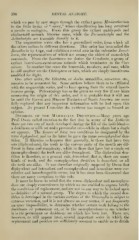Page 386 - My FlipBook
P. 386
39G DENTAL ANAT03IY. —
which we pass by easy stages through the extinct genus 3Ieniscotherium
to the little hyrax or " coney," whose classification has long remained
a puzzle to zoologists. From this group the extinct aniblypods and
elephantoid animals likewise came, while the Ferissodadyla and the
AHiodaciyla are traceable directly to it.
The unguiculate series also has a generalized order, from which all
the others radiate in dilierent directions. This order has been called the
Bunothcria by Cope, and exhibits a central axis in the sub-order Insecf-
ivora, the representatives of which are among the oldest of monodelph
mammals. From the Insectivora we derive the Creodonta, a group of
extinct insectivoro-carnivorous animals which terminates in the Car-
nivora. In another line come the lemuroids, monkeys, and man, while
in still another are the Cheiroptera or bats, which are simply insectivores
modified for flight.
One other order, the Edentata, or sloths, armadillos, ant-eaters, etc.,
remains to be accounted for. Some authors believe them to be affiliated
with the unguiculate series, and to have sprung from the central insect-
ivorous group. Palaeontology has so far given us very few if any hints
concerning the origin of this order, and it is probable that it will not
be until the Eocene and Miocene Tertiaries of South America are more
fully explored that any important information Mill be had upon this
subject. At present I consider the evidence too meagre to hazard an
opinion.
Divisions of the Mammalian Dentition.—Many years ago
Prof. Owen called attention to the fact that in many of the Entheria
there are two sets of teeth developed during the life of the individual
a deciduous or milk set and a permanent set—while in others but a single
set appears. The former of these two conditions he designated by the
term diphyodont, and to the latter he gave the name monophyodont den-
tition. It likewise so happens that generally, in those that have tM'O
sets (diphyodonts), the teeth in the various parts of the mouth are dif-
ferent in form and complexity, while in those that have but a single set
(monophyodonts) the teeth are alike throughout. The diphyodont den-
tition is therefore, as a general rule, hcterodont, that is, there are many
kinds of teeth, and the monophyodont dentition is homodont, or all
the teeth are alike. It was therefore originally supposed by Owen that
diphyodont and heterodont and monophyodont and homodont were cor-
relative and interchangeable terms, but it has since been discovered that
there arc many exceptions to this rule.
It must be borne in mind that the terms diphyodont and monophyo-
dont are simply conveniences by which we are enabled to express briefly
the conditions of replacement, and are not in any way to be looked upon
as definitive of a natural group. The degree to which the second den-
tition is developed in the various sections of the INIammalia is subject to
extreme variation, and it is not always an easy matter, if not frequently
an utter impossibility, to determine whether certain teeth belong to the
deciduous or permanent set, or in the monophyodonts to say whether
it is the permanent or deciduous set which has been lost. There are,
however, as will appear later, several important series in which the
replacement and position are sufficiently constant to enable us to divide


